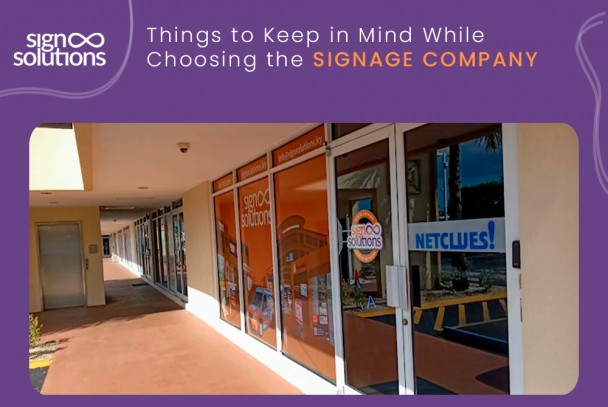Sign Solutions has been our "Go-To" source for all of our Corporate sign, banner and vehicle branding needs for years. Their team is always extremely responsive and their product quality is exceptional for the price. We highly recommend the services of the Sign Solutions!
Digital Transformation: Interactive Indoor Retail Signs for Engaging Shopping Experiences
From Browsing to Buying: Interactive Indoor Retail Signage for an Engaging Shopping Experience
Have you ever walked into a store and been captivated by the interactive displays that seem alive before your eyes? In today's digital age, traditional retail signage doesn't cut it anymore.
Consumers crave a more immersive and engaging shopping experience, and interactive indoor retail signage is the answer. From browsing to buying, this innovative technology is revolutionizing how people shop at retail outlets and malls.
Join us as we explore how interactive indoor retail signage transforms the retail landscape and creates unforgettable experiences for shoppers everywhere.
Understanding Interactive Indoor Retail Signage
Traditional retail stores face tough competition from online retail giants in today's digital age. As more consumers turn to e-commerce for shopping, brick-and-mortar retailers must find ways to adapt and stay relevant in a rapidly changing market.
One unique solution that has emerged is interactive indoor retail signage. Unlike any other, this innovative technology combines the benefits of physical and digital shopping experiences, creating an engaging and seamless browsing-to-buying journey for customers.
But what exactly is interactive indoor retail signage? Simply put, it refers to any screen or display within a store that allows two-way interaction between the customer and the brand. It can include touchscreens, interactive kiosks, augmented reality displays, and smart mirrors.
Interactive indoor retail signage is vital in digital transformation because it bridges the gap between physical and online shopping. It allows retailers to provide personalized experiences that were once only available through e-commerce platforms.
With these interactive displays, customers can easily browse through a store's entire inventory at their own pace without feeling pressured by salespeople. They can also access product information, reviews, and recommendations with just a few taps on a screen.
These displays make it easier for customers who know what they want but don't have time to search for it throughout the store to locate specific products quickly. Interactive indoor retail signage is not just a tool but a game-changer for traditional retailers looking to stay competitive in a digital world. It improves customers' shopping experience and offers numerous benefits for businesses.
Benefits of using interactive indoor retail signage for both retailers and customers
In the fiercely competitive retail industry, creating a memorable and engaging shopping experience is key to attracting and retaining customers. A standout solution in this endeavor is interactive indoor retail signage. These digital displays provide information about products and promotions and facilitate real-time customer interaction, setting them apart from traditional signage. This section will delve into the unique benefits of interactive indoor retail signage to retailers and customers.
For retailers, the most significant advantage of interactive indoor retail signage is its power to boost customer engagement. Unlike traditional static signs that often go unnoticed, these digital displays are designed to captivate customers and encourage them to interact with the displayed content. This can range from playing games to answering surveys or making direct purchases. By involving customers in an entertaining and informative manner, retailers can craft a shopping experience that is both personalized and memorable.
Another benefit for retailers is the flexibility and versatility of interactive indoor retail signage. Once printed and installed, traditional static signs cannot be changed without significant cost and effort. On the other hand, digital displays allow for easy updates and changes in messaging or promotions as needed. They will enable retailers to quickly respond to market trends or adjust their messaging based on customer feedback.
Interactive indoor retail signage enhances customer engagement and offers retailers a wealth of data collection capabilities. Through integrated cameras or Wi-Fi monitoring technology, these displays can track customer interactions such as clicks, time spent on specific content, or demographic information.
This data is a goldmine of insights into customer behavior patterns,
which can be leveraged to shape future marketing strategies.
Additionally, interactive digital displays provide customers with more detailed and relevant product information. Customers can make more informed purchasing decisions through product demonstrations, videos, or virtual try-on features. This added level of engagement can also increase customer satisfaction and loyalty.
The use of interactive indoor retail signage is a win-win for both retailers and customers.
- For retailers - it enhances customer engagement, provides flexibility in messaging and promotions, and offers valuable data collection capabilities.
- For customers - it creates an engaging shopping experience and provides more detailed product information.
By incorporating interactive retail signage into their stores, retailers can elevate their customers' overall shopping experience.
Types of interactive indoor retail signage and their features
Interactive indoor retail signage has become essential to modern retail stores, enhancing customers' shopping experience and driving business sales. With technological advancements, various interactive indoor retail signage offers different features to engage and entice shoppers.
This section will explore the most popular interactive indoor retail signage types and their unique features.
1. Touchscreen Signage:
Touchscreen signage lets customers interact directly with the display by tapping or swiping. These displays are highly intuitive and user-friendly, making it easy for shoppers to browse through products and information. They also offer a more personalized experience as users can select their preferences or enter their information for targeted recommendations.
One key feature of touchscreen signage is its ability to display high-quality images and videos, providing a visually appealing experience for customers. It also allows retailers to showcase their entire product range without physically stocking them in-store.
2. Augmented Reality Signage:
Augmented reality (AR) is a technology that superimposes digital elements onto the real-world environment. AR signage lets shoppers visualize products in a virtual setting, giving them a better idea of how they would look or fit into their space before purchasing.
This signage enhances customer engagement by creating an interactive and immersive experience. Customers can interact with the AR display using gestures or movements, which makes them feel like they are trying out real-life products.
3. Near Field Communication Signage:
Near Field Communication (NFC) utilizes radio waves to transfer data between two electronic devices when placed close together. NFC-enabled signs allow customers to tap their smartphones against the sign to access product information, promotions, or discounts.
One of the main advantages of NFC signage is its convenience. There is no need to download apps or scan QR codes. Customers receive all the relevant information with just one tap.
4. Gesture-Based Signage:
Gesture-based signage uses motion sensors to detect movements and respond accordingly. It is highly interactive and can create a memorable shopping experience for customers.
For example, a customer could wave their hand in front of the display to see more product details or use gestures to navigate different options. Gesture-based signage is just one of the many interactive indoor retail signage options available. It is also a great way to capture attention and stand out from traditional static signs.
While each signage type offers unique features and benefits, they all share a common goal—to enhance customers' overall shopping experience. As technology advances, we can anticipate even more innovative and engaging forms of retail signage, making signage a future-proof investment for your retail store.
Case studies of successful implementation of interactive indoor retail signage in various industries
Interactive indoor retail signage has become increasingly popular in various industries to enhance the shopping experience and drive sales.
This section will explore case studies of successful implementations in different industries.
1. Fashion Retail: Hugo Boss
Hugo Boss, a luxury fashion brand, implemented interactive digital mirrors in their flagship store in London. These mirrors allow customers to see themselves virtually dressed in the latest collection while giving them access to product information and recommendations. This interactive experience engages customers and helps them make informed purchase decisions. As a result, Hugo Boss saw increased sales and improved customer satisfaction.
2. Beauty Retail: Sephora
Sephora, a leading beauty retailer, introduced "Magic Mirrors" in its stores. These mirrors use augmented reality technology to enable customers to try makeup virtually, allowing them to experiment with different shades and products without physically applying them to their skin. The mirrors also provide personalized recommendations based on the customer's skin tone and preferences. This immersive experience has not only increased customer engagement but also led to an increase in average basket size by 13%.
3. Home Improvement Retail: Lowe's
Lowe's, a home improvement retailer, launched an Augmented Reality (AR) app that allows customers to visualize how furniture or appliances would look in their homes before purchasing. The app enables customers to use their smartphone cameras to view 3D models of products placed within their room space. This feature has proven to be highly beneficial for customers and the company as it reduces the chances of returns due to wrong measurements or unsuitable products.
4. Grocery Retail: Tesco
Tesco, one of the largest supermarket chains, introduced virtual reality headsets at some of its stores for customers who cannot visit physical supermarkets due to illness or disability restrictions. With these headsets, customers can browse through aisles and make purchases virtually. This initiative caters to a previously overlooked segment of customers and provides a unique and convenient shopping experience.
5. Food and Beverage Industry:
The food and beverage industry has also embraced interactive indoor retail signage to attract customers and enhance their dining experience. McDonald's, one of the world's largest fast-food chains, installed self-service kiosks with touchscreen menus, allowing customers to customize their orders, view nutritional information, and make payments digitally without waiting in line.
Similarly, Starbucks introduced augmented reality (AR) experiences through its mobile app. While waiting for orders, customers could scan signs or posters inside their stores for exclusive content, such as recipes or games.
6. Home Décor Retail:
Home décor retailers use interactive indoor retail signage to showcase their products and inspire potential buyers with design ideas. IKEA is a prime example of this, as it implemented "magic mirrors" that use AR technology to simulate furniture placement within a customer's home environment.
Moreover, home improvement giant Lowe's has incorporated 3D mapping technology to create virtual home designs for customers, helping them visualize their renovation projects before purchasing.
These case studies demonstrate the successful implementation of interactive indoor retail signage in various industries. From fashion to food and even home décor, this technology has proven effective in engaging customers and enhancing their shopping experience. As we move towards a more digitally driven world, interactive indoor retail signage will continue to evolve and play a crucial role in the retail industry.
How to create effective and engaging content for interactive indoor retail signs
An effective way to create engaging content is by developing and installing interactive indoor retail signs. These digital displays provide information about products and promotions and engage shoppers with interactive elements, creating a more memorable and enjoyable shopping experience.
But how can retailers ensure their indoor retail signs are effective and engaging? Here are some tips on creating content that will captivate your audience and drive sales.
- Knowing your target audience: Identifying your target audience is the cornerstone of creating compelling content for interactive indoor retail signs. This knowledge allows you to tailor your content to their interests and preferences. For example, if your target audience is tech-savvy millennials, incorporating gamification or social media integration into the display can increase engagement and sales.
- Keep it concise: Your messaging must be short and sweet with limited screen space. Use eye-catching visuals and brief yet impactful text to convey your message quickly. Avoid cluttering the display with too much information, as it can overwhelm viewers and defeat the purpose of an interactive sign.
- Leverage multimedia: Don't be afraid to mix up different forms of media, such as videos, animations, GIFs, or even music, to make your content more engaging. Adding movement or sound can capture people's attention better than static images or text alone.
- Make it personal: Personalization is not just a strategy; it's the key to creating successful interactive content for retail signage. It's about making your audience feel seen and understood, likely leading to engagement and sales. People are more likely to engage with something customized rather than a generic message meant for everyone.
- Encourage interaction: The whole point of having an interactive indoor retail sign is to get the viewer involved in some way actively. Whether through touchscreens or QR codes that lead to special offers or discounts, find ways to encourage shoppers' participation and make them feel like they're part of the experience.
- Keep it fresh: Regularly changing your content is not just a suggestion; it's a crucial task that keeps your audience interested and engaged. Consider updating your displays with new promotions, seasonal themes, or relevant trending topics. This keeps shoppers engaged and returning for more, ultimately leading to more sales and a better shopping experience.
Following these tips can help you create effective and engaging content for your interactive indoor retail signs, entice shoppers to stop, interact, and ultimately initiate a purchase.
Always keep your target audience in mind and strive for creativity in your messaging to stand out. A well-crafted content can transform “Browsing into Buying” and provide an unforgettable shopping experience for your customers.
Change
Browsing Thoughts
into a
Buying Attitude
Best practices for integrating interactive indoor retail signage into the overall shopping experience
In today's digitally focused world, retailers must stay ahead of the curve and provide their customers with an interactive shopping experience. One powerful tool to achieve this is the integration of interactive indoor retail signage into store design.
These digital displays enhance your store's overall aesthetic, give customers a unique and engaging shopping experience, and increase their satisfaction and loyalty.
But how exactly can you effectively integrate interactive indoor retail signage into your overall shopping experience? Here are some best practices to keep in mind:
- Strategic Placement: The placement of your interactive signs is crucial in capturing shoppers' attention. Consider placing them in high-traffic areas like near entrances, checkout counters, or popular product displays. This will ensure maximum visibility and engagement from customers.
- Clear and Concise Messaging: With limited time and attention spans, it is important to keep your messaging on these displays clear and concise. Use short phrases or bullet points that quickly convey a product's or promotion's benefits or features.
- Engaging Content: Interactive signage is all about engaging customers, so make sure your content is compelling and interactive. This can include various elements such as videos showcasing product features, quizzes to test customer knowledge, games to entertain, or product demonstrations to educate. The more entertaining and informative the content, the more likely customers will be to interact with it.
- User-Friendly Interface: Your interactive signage interface should be intuitive and user-friendly. Ensure it is easy for customers to navigate and understand how to interact with the display. This will encourage more people to engage with the content.
- Brand Consistency: Your interactive signage should align with your brand's overall aesthetic and messaging. This will help reinforce your brand identity and create a cohesive customer shopping experience.
- Regular Updates: It is crucial to regularly update the content on your interactive signs to keep customers engaged. This can include new products, promotions, or seasonal campaigns. Regular updates ensure that your content remains fresh and relevant, preventing it from becoming stale or outdated, which can quickly turn off customers.
- Integration with Other Technologies: Consider integrating your interactive signage with other technologies like mobile apps or QR codes. This can enhance the shopping experience and provide a seamless transition between online and in-store interactions.
- Test and Analyze Performance: As with any marketing strategy, it is important to test and analyze the performance of your interactive signage. This will help you understand what content and placement resonate best with your customers, allowing you to adjust and improve future campaigns.
By following these best practices, you can effectively integrate interactive indoor retail signage into your overall shopping experience. This will enhance your store's aesthetic, engage and delight customers, and increase sales and brand loyalty.
The Future of Interactive Indoor Retail Signage: Advancements and Possibilities
As technology advances rapidly, so does the potential for interactive indoor retail signage. With the rise of e-commerce and online shopping, brick-and-mortar stores are constantly looking for ways to create an engaging and immersive shopping experience that will entice customers to purchase in-store.
Augmented reality (AR) and virtual reality (VR) are game-changers in interactive retail signage. These technologies offer customers a more lifelike product visualization, helping them to envision themselves using or wearing the items. By integrating AR/VR into their signage, retailers can deliver a unique and unforgettable shopping experience, increasing sales and customer satisfaction.
Artificial intelligence (AI) is revolutionizing interactive indoor retail signage. AI-powered smart displays can interpret customer behavior and preferences using facial recognition technology, offering personalized recommendations and deals based on their data. This elevates the shopping experience and equips retailers with crucial insights into consumer behavior.
Voice-controlled digital assistants like Amazon's Alexa or Google Home make shopping more convenient. Customers can now interact with these devices through voice commands to learn about products or get assistance while browsing. This technology streamlines the shopping experience, increasing efficiency and customer satisfaction.
Moreover, advancements in touchscreen display technology have allowed for more creative and interactive content on digital signage. With multi-touch capabilities, customers can engage with screens by swiping, zooming, pinching, or tapping images for more information. This not only makes the shopping experience more enjoyable but also provides retailers with another opportunity to showcase their products innovatively.
The future of interactive indoor retail signage is bright and constantly evolving. These advancements benefit customers by providing a more engaging and convenient shopping experience and providing retailers with valuable consumer behavior insights. As technology advances, we can expect to see even more innovative uses of interactive signage in retail spaces.
Conclusion
Implementing interactive indoor retail signage has revolutionized the shopping experience by bridging the gap between browsing and buying.
By offering engaging and personalized content, these digital displays empower customers to make informed purchasing decisions while enhancing their shopping journey.
As technology continues to evolve, the future of retail signage holds promising opportunities for further innovation and customer engagement in the dynamic retail industry.
Know Us: We are Sign Solutions, Cayman Islands
Sign Solutions Cayman Islands offers excellent, customer-satisfying signage solutions. We specialize in custom indoor and outdoor signage for businesses of all sizes and tailor our signage to meet your needs.
At Sign Solutions Cayman Islands, we take pride in staying ahead of the curve. We lead in technology and design trends. This helps us offer our clients the latest signage innovations. Whether digital displays, illuminated signs, wayfinding systems, or vehicle wraps, we have the expertise and creativity to meet all signage needs with precision and style.
Our skilled designers and technicians are experts in their fields. Our teams assist clients from concept to installation. Our customized signage solutions enhance your unique vision and leave a lasting impression.
Sign Solutions Cayman Islands is the clear choice for elevating branding and visibility. Our impactful signage solutions are designed to make a bold statement and help your business stand out. With our unparalleled expertise, we can transform your signage into a powerful marketing tool.
Recent Blog

How Custom Awning Signs Help Cayman Startups Build a Strong First Impression
It’s just not the Cayman Islands but the world over, where first impressions are not just crucial, but a decisive force driving your prospective cus...
Read More
Time for a Refresh: Signage Mistakes That Make Your Business Appear Unprofessional
Ever thought why some advertisements always catch our attention and become a permanent resident of our memory, while others never appeal to us? The si...
Read More
Stand Out Day or Night: The Power of Backlit Signage for Your Business
When seeing is believing, visibility goes beyond the basic conventions in spreading the awareness of your brand, far and wide. When a customer walks d...
Read More
Easy Ways to Create Stylish Interiors with Custom Signage
Imagine that you visit a store as a customer that houses various products. You enter the store and observe that the store only has products on display...
Read More
Things to Keep in Mind While Choosing the Signage Company
Would you prefer visiting a doctor to get your ailment diagnosed or simply consume a medicine suggested by a friend who doesn’t belong to the medica...
Read More









